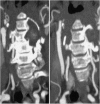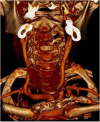Surgical nuances on the treatment of giant dumbbell cervical spine schwannomas: description of a challenging case and review of the literature
- PMID: 28053744
- PMCID: PMC5129399
- DOI: 10.1038/scsandc.2015.42
Surgical nuances on the treatment of giant dumbbell cervical spine schwannomas: description of a challenging case and review of the literature
Erratum in
-
Erratum for Spinal Cord Series and Cases content published prior to July 2016.Spinal Cord Ser Cases. 2016 Jul 21;2:16019. doi: 10.1038/scsandc.2016.19. eCollection 2016. Spinal Cord Ser Cases. 2016. PMID: 31265710 Free PMC article.
Abstract
We report a case of a giant intra and extradural cervical schwannoma in a patient affected by a severe myelo-radiculopathy. Clinical features, diagnosis and the issues concerning the surgical management of this benign tumor are discussed. We also review similar cases previously reported in the literature. A 50-year old caucasian woman was complaining of a 1 year of neck pain and worsening motor impairment in all four limbs causing the inability to walk. Neuroradiological assessment revealed a suspected schwannoma involving the nerve roots from C3 to C5, compressing and deviating the spinal cord. The vertebral artery was also encased within the lesion, but still patent. A posterior cervical laminectomy with a microsurgical extradural resection of the lesion was performed. Moreover, an accurate dissection of the lesion from the vertebral artery and the resection of the intraspinal component was achieved. Vertebral fixation with screws on the lateral masses of C3, C5 and C6 and a hook on C1 was performed. The procedure was secured using electroneurophysiological monitoring. A progressive improvement of the motor functions was achieved. A cervical post-contrast MRI revealed optimal medullary decompression and a gross-total resection of the lesion. Schwannomas are benign, slowly growing lesions which may cause serious neurological deficit. Early diagnosis is necessary and it maybe aided by imaging studies such as MRI or CT. The accepted treatment for these tumors is surgical resection and, when indicated, vertebral fixation.
Keywords: CNS cancer; Neurological manifestations.
Figures





References
-
- Heros RC . Lateral suboccipital approach for vertebral andvertebrobasilar artery lesions. J Neurosurg 1986; 64: 559–562. - PubMed
-
- Lot G , George B . The extent of drilling in lateral approaches to the cranio-cervical junction area from a series of 12 cases. Acta Neurochir (Wien) 1999; 141: 111–118. - PubMed
-
- Levy WJ , Latchaw J , Hahn JF , Sawhny B , Bay J , Dohn DF . Spinalneurofibromas: a report of 66 cases and a comparison with meningiomas. Neurosurgery 1986; 18: 331–334. - PubMed
-
- Ozawa H , Kokubun S , Aizawa T , Hoshikawa T , Kawahara C . Spinal dumbbell tumors: an analysis of a series of 118 cases. J Neurosurg Spine 2007; 7: 587–593. - PubMed
-
- Su X , Ni LC , Yan YH , Zhao W , Chen J . Giant dumbbell-shaped lumbar schwannoma. Spine J 2013; 13: 984. - PubMed
LinkOut - more resources
Full Text Sources
Other Literature Sources
Miscellaneous

